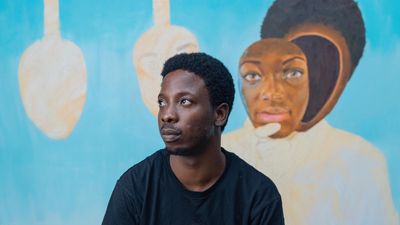Spotlight: Nigerian Artist Festus Alagbe Is Unmasking Your True Identity
We spoke with the visual artist on identity and letting your intuition guide you to success.
In our 'Spotlight' series, we highlight the work of photographers, visual artists, multimedia artists, and more who are producing vibrant, original work.
In our latest piece, we spotlight Nigerian visual artist Festus Kehinde Alagbe. The painting major comes from a family of creatives and entrepreneurs and uses his life experiences and understandings to reflect messages back to the society to which he belongs. Acknowledging his strengths and choosing to focus his energy on his creative pursuits, Alagbe uses the concept of 'masking' to reveal the hidden meaning behind the norms that society has placed upon us. Paul Laurence Dunbar's poem 'We Wear The Mask', acts as a great inspiration for the young artist, as his understanding of human nature led him to portray his artistic subjects as unmasking and masking whichever expression they believe will suit the mood. Alagbe's work also illustrates how the everyday person copes with the harsh realities of life on Earth.
We spoke with the artist about his current spot in Ghana's Noldor Artist Residency, allowing yourself to learn more about your craft, and the pressure that comes with identity.
Responses have been edited for length and clarity.
Describe your background as an artist and the journey you've taken to get it to where it is today.
My artistic journey began in childhood: I was born into a family that holds entrepreneurs and creatives in high esteem. And we're all creative -- my parents were fashion designers, and, likewise my twin brother.
I’m an instinctive artist. I have always wanted to express my imaginations and experiences in a visual form -- either on a two-dimensional surface or in three-dimensional form. That which I can not express with words, I want to express as messages that people can learn from, relate with, and encourage society. But, knowing that instincts aren't enough, I joined The Polytechnic, Ibadan's Department of Art and Design as a painting major to be mentored and become a professional Artist. I became a full-time artist when graduated from school.
I’m currently a Visiting Fellow at the Noldor Artist Residency in Accra, Ghana.
What are the central themes in your work?
I capture different bisected facial expressions to represent time and seasons in the form of masks. I believe that the range of expressions that a face creates is not the true identity. Facial expressions are subject to the situation of society. “We wear the mask that grins and lies, it hides our cheeks and shades our eyes,” says a poem titled “We Wear The Mask” by Paul Laurence Dunbar.
The true Identity is hidden inside every individual. The characters you exhibit will be determined by the kind of seeds you sow into yourself -- either love or hatred. I use flowers to capture love, passion, seasons, and transient time. The elements I use in the back are biomorphic and fluid in shape, depicting structures and institutions in the world. I also capture and depict Black bodies bursting through with floral elements, referring to the optimism that lies with the pain of being Black, depicting a sense of growth and resilience in the face of ubiquitous racial prejudice and adversity largely faced by people of color. And the flowers bursting through different genders captures different emotions and expressions.
What is your medium of choice, and why?
I use various mediums to express myself, like acrylic, oil, charcoal, etc. I use different mediums as a professional artist because I don’t want to be limited to a medium before I can express myself.
Recently, I uses oil to detail my subject (faces) and acrylic for the background because it dries faster and can be controlled easily.
How has the pandemic affected you creatively?
It has actually affected me in the area of market value and the unavailability of materials to work. But all glory to God for today.
Can you describe your artistic relationship with ‘Afro-futurism' and 'Surrealism’?
I’m a surreal artist of African origin. So, my artistic practice is based on surrealism from an African perspective to address some situations or issues in society at large. I strike a balance between realism, fantasy, and imagination. Afrofuturism addresses themes and concerns of the African diaspora through technoculture and speculative fiction, encompassing a range of media and artists with a shared interest in envisioning Black futures that stem from Afro-diasporic experiences. While Afrofuturism is most commonly associated with science fiction, it can also encompass other speculative genres such as fantasy, alternate history, and magic realism. These are what make my practice relate to Afro-futurism.
Can you talk about your use of colors and jewelry in your art?
I use dark skin tones and colors to depict Black faces with bodies, and I use monochrome colors to explore abstract landscapes as my background. And the abstraction elements in the back are biomorphic and fluid in shape which is the representation of structures and institutions in the world and society.
Image courtesy of the artist
'Split Intent' 2022
▲
Image courtesy of the artist
'Ebony, Daughter of Grace' 2022
▲
Image courtesy of the artist
'King Omofemi' 2022
▲
Image courtesy of the artist
'Monday Best' 2022
▲
Image courtesy of the artist
'Oluwa Enigma' 2022
▲
Image courtesy of the artist
An artist at work
▲
